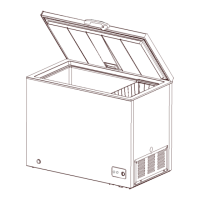
Do you have a question about the Midea CHEST FREEZER Series and is the answer not in the manual?
| Energy Efficiency | Varies by model |
|---|---|
| Color | White |
| Refrigerant | R600a |
| Defrost Type | Manual |
| Warranty | 1-year limited warranty |
| Power Consumption | Varies by model |
| Voltage | 115V, 60Hz |
| Weight | Varies by model |
| Dimensions (W x D x H) | Varies by model |
| Number of Baskets | 1 |
Provides crucial safety instructions for operating the appliance, emphasizing user protection and hazard avoidance.
Details safety precautions related to flammable refrigerants, emphasizing professional handling and disposal procedures.
Provides guidance on safely moving and positioning the refrigerator, including pre-operation waiting times.
Explains procedures for dismantling and reassembling refrigerator doors, particularly for room entry.
Recommends optimal placement for ventilation, heat dissipation, and energy efficiency.
Instructions on adjusting the refrigerator's footing to ensure stability on uneven surfaces.
Details on how to reverse the door swing direction for improved accessibility.
Step-by-step guide for attaching the door handle and lock loop securely.
Procedure for installing the door lock mechanism, often integrated with handle installation.
Methods for aligning the door to ensure proper sealing and appearance.
Guidance on adjusting interior shelves for optimal storage and organization.
Clarification of product model naming conventions and specifications.
Guidance on finding the appliance's identification and specification nameplate.
Details on specific product variants and their classifications.
Comprehensive data on voltage, current, power consumption, and component electrical properties.
Specifies the target temperature ranges for freezing and refrigerating compartments.
Lists components involved in the automatic or manual defrosting cycle.
Visual representation of the electrical connections and components within the appliance.
Identifies and labels the key internal components and structural elements of the freezer.
Provides detailed measurements for the freezer's exterior, including height, width, and depth.
Diagram and description of the refrigerant flow path through the cooling system.
Illustration of how air circulates within the freezer for effective cooling.
Instructions for safely removing components attached to the freezer door, like seals and covers.
Guidance on disassembling and removing internal components like baskets and covers.
Details on how to access and service the internal lighting components.
Information on removing and checking evaporator and sensor components.
Procedures for accessing and servicing the condenser unit.
Instructions for removing or accessing the compressor housing.
Diagram and labeling of the temperature control box assembly and its components.
Explanation of the freezer's control panel, icons, and buttons.
Guidance on setting and adjusting the desired internal temperature.
Information on indicator lights and alarms related to freezer status.
Instructions for performing manual defrosting procedures and maintenance.
Details of the electrical power input and distribution.
Information on testing the door switch's electrical circuit.
Description of circuits used for temperature testing and monitoring.
Circuit diagram for the freezer compartment fan.
Circuit diagram for the refrigerating compartment fan.
Details of the condensation fan's electrical circuit.
Circuitry for the fan motor located at the ventilation door.
Specific resistance values for temperature sensors at different temperatures.
Provides a diagnostic flowchart for troubleshooting issues related to the freezer not cooling effectively.
Diagnostic steps for addressing situations where the compressor fails to operate.
Troubleshooting guide for thermostat issues leading to excessive cooling.
Steps to diagnose and fix problems with the internal freezer light.
Guide to identifying and resolving unusual noises originating from the appliance.
Illustrations and diagrams showing exploded views of freezer components.
Detailed inventory of replaceable parts with their specifications and BOM codes.
Lists necessary tools, equipment, and materials for performing maintenance and repairs.
